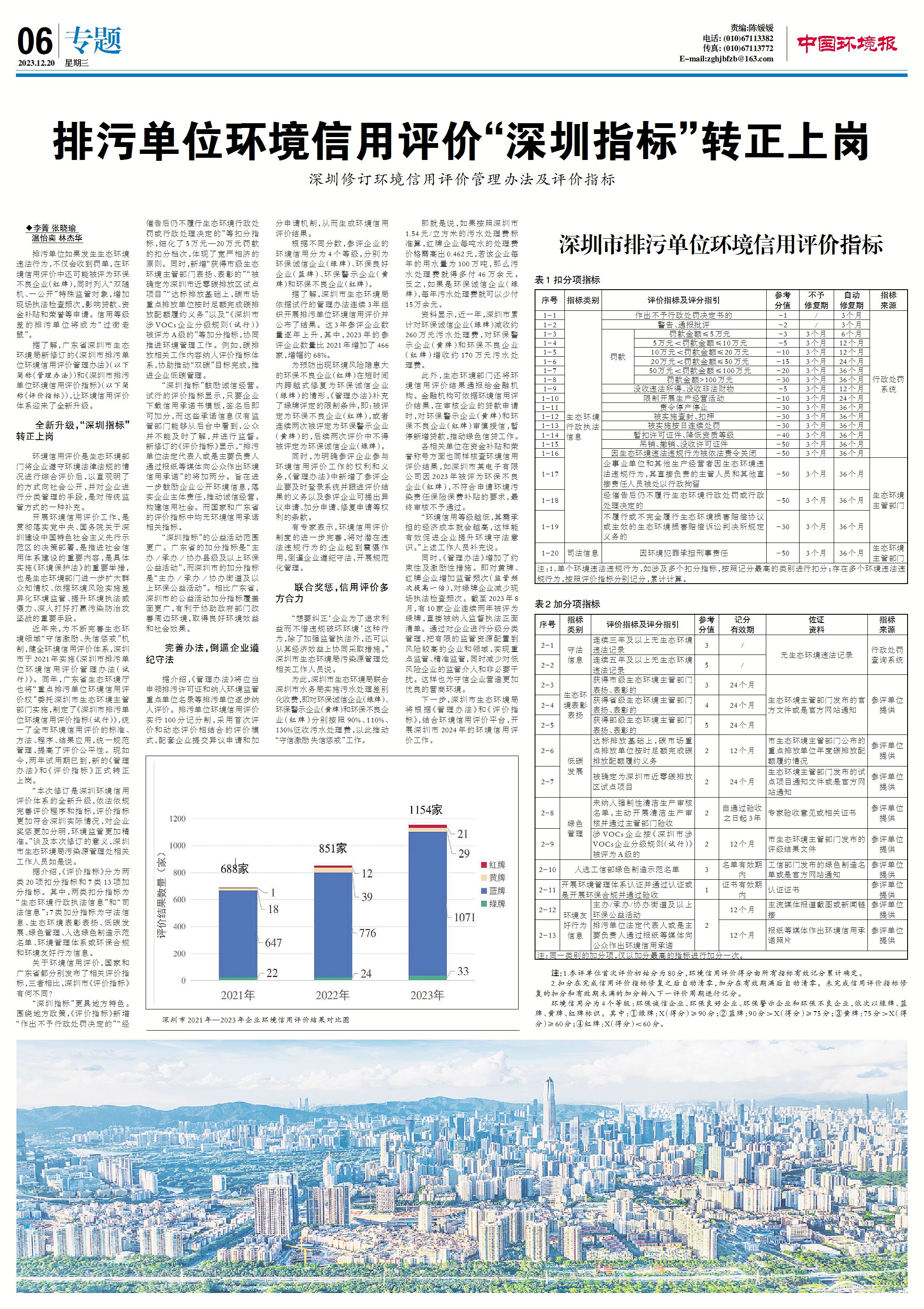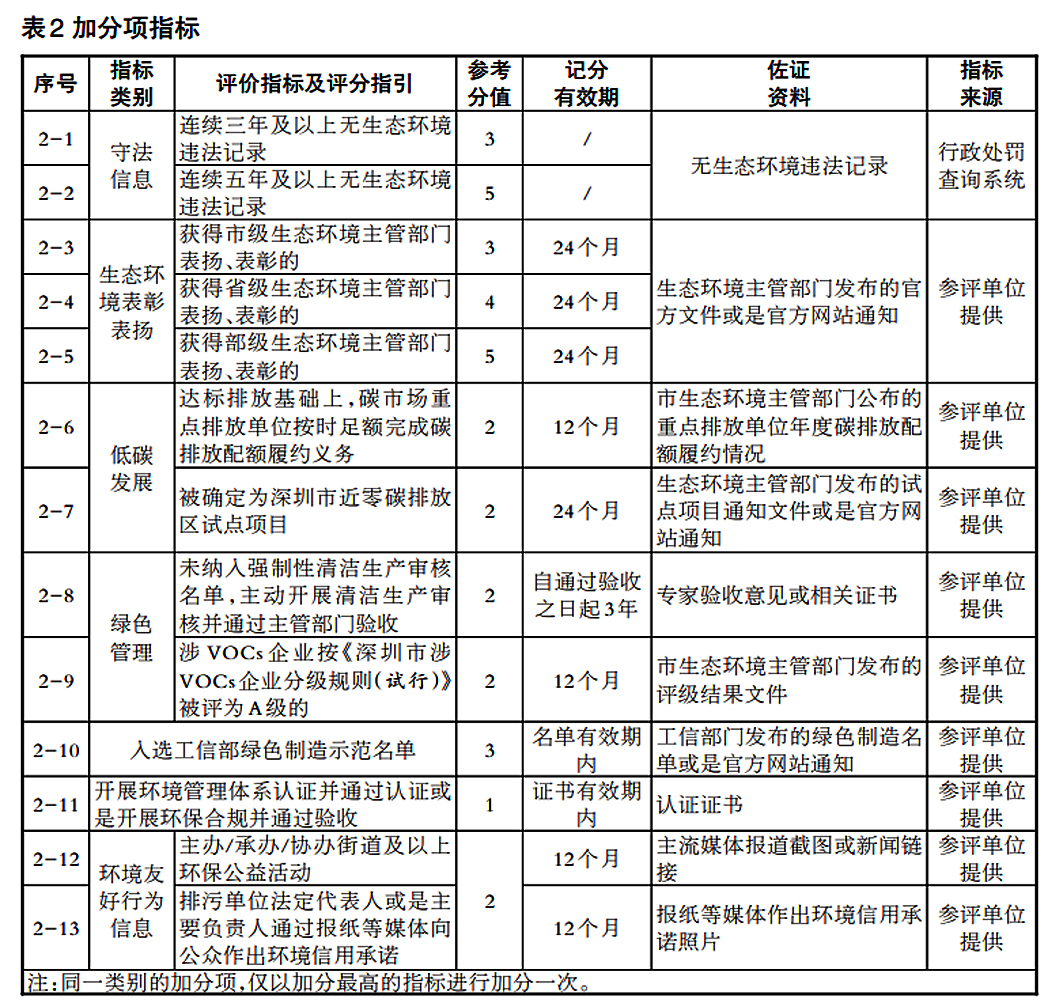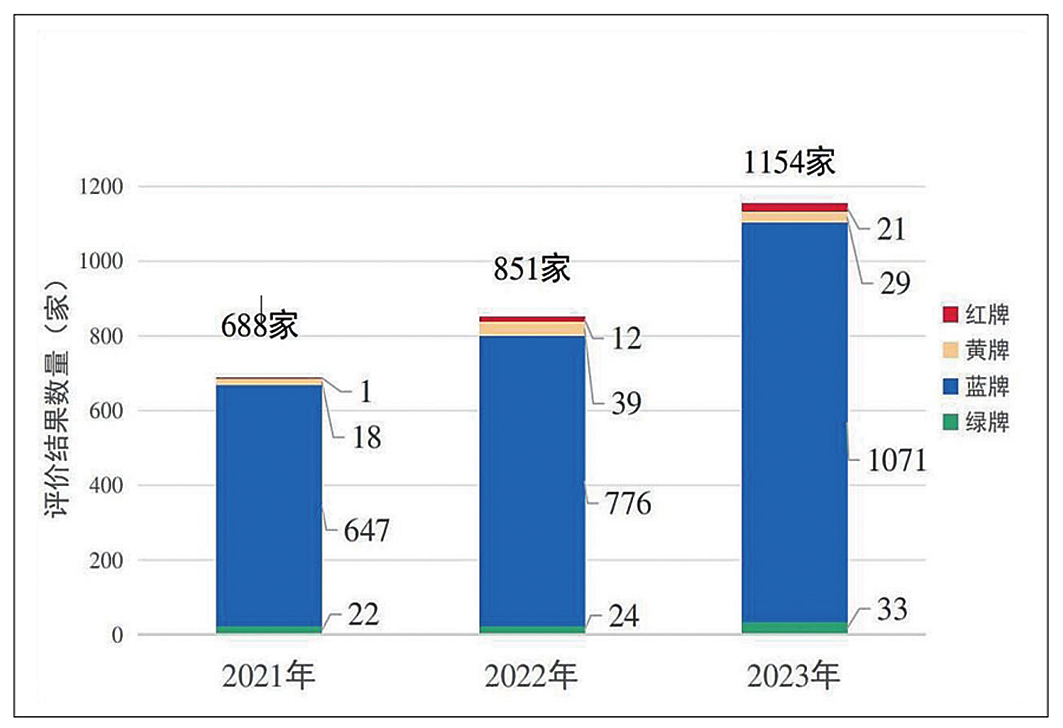The "Shenzhen Index" of the environmental credit evaluation of pollutant discharging units has been turned into a regular post

If a pollutant discharger violates the ecological environment, it will not only receive a fine, but may also be rated as a bad environmental protection enterprise (red card) in the environmental credit evaluation, and at the same time be included in the "double random, one open" special supervision object, increase the frequency of on-site law enforcement inspections, and affect the application for loans, capital subsidies and honors. Pollutant dischargers with poor credit ratings will become "street rats".
It is understood that the newly revised "Shenzhen Pollutant Discharge Unit Environmental Credit Evaluation Management Measures" (hereinafter referred to as the "Management Measures") and "Shenzhen Pollutant Discharge Unit Environmental Credit Evaluation Index" (hereinafter referred to as the "Evaluation Index") of the Shenzhen Municipal Bureau of Ecology and Environment have ushered in a new upgrade of the environmental credit evaluation system.
Environmental credit evaluation index of pollutant discharging units in Shenzhen


Note: 1. The initial score of the first evaluation of the participating units is 80 points, and the score of the environmental credit evaluation is determined by the cumulative effective scores of all indicators. 2. The deducted points are automatically cleared after the credit evaluation index is repaired, and the extra points are automatically cleared after the expiration of the validity period. Where the restoration of credit assessment indicators has not been completed, the deducted points and the additional points that have not yet completed the validity period will be transferred to the next assessment cycle for scoring. The environmental credit is divided into 4 levels: environmental integrity enterprise, good environmental protection enterprise, environmental protection warning enterprise and environmental protection poor enterprise, which are identified by green card, blue card, yellow card and red card in turn. Among them: (1) Green card: X (score) ≥ 90 points; (2) Blue card: 90 points> X (score) ≥75 points; (3) Yellow card: 75 points> X (score) ≥ 60 points; (4) Red card: X (score) < 60 points.
Newly upgraded, "Shenzhen index" turned into a regular post
Environmental credit evaluation is a means for the ecological environment department to disclose to the public in an intuitive and clear way after a comprehensive evaluation of the enterprise's compliance with environmental laws and regulations, and to classify and manage the enterprise, which is a supplement to the traditional supervision method.
Carrying out environmental credit assessment work is an important part of implementing the decisions and arrangements of the Party Central Committee and the State Council on Shenzhen's construction of a pilot demonstration zone of socialism with Chinese characteristics, an important part of promoting the establishment of a social credit system, an important measure for the specific implementation of the Environmental Protection Law, and an important means for the ecological and environmental departments to further expand the public's right to know, implement differentiated environmental supervision based on environmental risks, enhance the deterrent effect of environmental law enforcement, and thoroughly fight and win the battle against pollution.
近年来,为不断完善生态环境领域“守信激励、失信惩戒”机制,健全环境信用评价体系,深圳市于2021年实施《深圳市排污单位环境信用评价管理办法(试行)》。同年,广东省生态环境厅也将“重点排污单位环境信用评价权”委托深圳市生态环境主管部门实施,制定了《Environmental credit evaluation index of pollutant discharging units in Shenzhen(试行)》,统一了全市环境信用评价的标准、方法、程序、结果应用,统一规范管理,提高了评价公平性。现如今,两年试用期已到,新的《管理办法》和《评价指标》正式转正上岗。
"This revision is a new upgrade of Shenzhen's environmental credit evaluation system, improving the evaluation procedures and indicators in accordance with laws and regulations, and the evaluation indicators are more in line with the actual situation in Shenzhen, the rewards and punishments for enterprises are more distinct, and the environmental supervision is more accurate." Talking about the significance of this revision, the relevant staff of the Pollution Source Management Department of the Shenzhen Municipal Ecological Environment Bureau said.
According to reports, the "Evaluation Index" is divided into two categories of 20 deduction indicators and 7 categories of 13 bonus indicators. Among them, the two types of deduction indicators are "ecological environment administrative law enforcement information" and "judicial information"; The 7 categories of bonus indicators are law-abiding information, ecological environment commendation and commendation, low-carbon development, green management, selected green manufacturing demonstration list, environmental management system, or environmental compliance and environment-friendly behavior information.
Regarding environmental credit evaluation, the state and Guangdong Province have respectively released relevant evaluation indicators, compared with the three, what is the difference between Shenzhen's "Evaluation Indicators"?
The "Shenzhen Index" has more local characteristics. Focusing on local policies, the "Evaluation Index" adds new deduction indicators such as "making a decision not to impose an administrative penalty" and "failing to perform the ecological and environmental administrative punishment or administrative treatment decision after being reminded", and refines the deduction grade of a fine of 50,000 yuan to 200,000 yuan, reflecting the principle of blending leniency and severity. At the same time, new bonus indicators such as "praised and commended by the municipal ecological and environmental authorities", "identified as a pilot project of Shenzhen's near-zero carbon emission zone", "on the basis of meeting the emission standards, key emitting units in the carbon market have completed their carbon emission quota performance obligations on time and in full", and "Shenzhen VOCs-related enterprise classification rules (trial)" have been rated as A-level, so as to promote environmental management in a coordinated manner. For example, carbon emissions-related work content is included in the evaluation index system to help promote the completion of the "dual carbon" goal and promote low-carbon management of enterprises.
The "Shenzhen Index" encourages honest management. The evaluation indicators of the trial show that as long as the enterprise downloads the credit commitment template, it can add points after signing, and these commitment information can only be seen by the regulatory authorities from the background, and the public cannot understand and supervise it in time. According to the newly revised "Evaluation Indicators", two points will be added for "the legal representative or main person in charge of the pollutant discharger who makes an environmental credit commitment to the public through newspapers and other media". It aims to further encourage enterprises to disclose environmental information, implement the main responsibilities of enterprises, promote honest management, and build a credit society. However, there are no indicators related to environmental credit commitments in the evaluation indicators of the state and Guangdong Province.
The scope of public welfare activities of the "Shenzhen Index" is wider. The bonus indicator for Guangdong Province is "hosting/undertaking/co-organizing environmental protection public welfare activities at the county level and above", while the bonus indicator for Shenzhen is "hosting/undertaking/co-organizing environmental protection public welfare activities at the street level and above". Compared with Guangdong Province, Shenzhen's public welfare activities have a wider coverage of the bonus indicators, which is conducive to assisting government departments to improve the surrounding environment and achieve good environmental and social benefits.
Comparison chart of Shenzhen's 2021-2023 enterprise environmental credit evaluation results

Improve the method to force enterprises to abide by the law
According to reports, the "management measures" will be applied for a pollutant discharge permit and included in the list of key environmental supervision units and other pollutant discharge units will be gradually included in the evaluation. The environmental credit evaluation of pollutant discharging units implements a 100-point scoring system, adopts an evaluation mode that combines the first evaluation and dynamic evaluation, and supports the mechanism for enterprises to submit objection applications and bonus point applications, so as to generate environmental credit evaluation results.
According to different scores, the environmental credit of the participating enterprises is divided into four levels, namely environmental integrity enterprise (green card), good environmental protection enterprise (blue card), environmental protection warning enterprise (yellow card) and environmental protection poor enterprise (red card).
It is understood that the Shenzhen Municipal Bureau of Ecology and Environment has organized and carried out the environmental credit evaluation of pollutant dischargers for three consecutive years in accordance with the trial management measures and announced the results. In the past three years, the number of participating companies has increased year by year, of which the number of participating companies in 2023 has increased by 466 compared with 2021, an increase of about 68%.
In order to prevent the occurrence of environmental protection enterprises with large potential environmental risks (red card) in a short period of time to repair by leaps and bounds to environmental integrity enterprises (green card), the "management measures" supplement the restrictions on green card assessment, that is: if it is assessed as an environmental protection enterprise (red card), or has been assessed as an environmental protection warning enterprise (yellow card) for two consecutive times, it shall not be assessed as an environmental protection integrity enterprise (green card) in the subsequent two evaluations.
At the same time, in order to clarify the rights and obligations of participating enterprises to participate in environmental credit evaluation, the "Administrative Measures" have added new provisions on the obligation of participating enterprises to log in to the system in a timely manner and follow up on the evaluation results, as well as the rights of participating enterprises to submit objection applications, bonus point applications, restoration applications, etc.
Some experts said that the further improvement of the environmental credit evaluation system will play a deterrent role in enterprises with potential violations of laws and regulations, and force enterprises to abide by the law and carry out standardized management.

Joint rewards and punishments, and multi-party joint efforts in credit evaluation
"If we want to correct the behavior of 'enterprises do not hesitate to violate laws and damage the environment in pursuit of profits', in addition to strengthening regulatory enforcement, we can also take coordinated measures from its economic benefits." The relevant staff of the Pollution Source Management Department of the Shenzhen Municipal Ecological Environment Bureau said.
To this end, the Shenzhen Municipal Bureau of Ecology and Environment and the Shenzhen Municipal Water Affairs Bureau have implemented differentiated sewage treatment fees, that is, 90%, 110% and 130% of the sewage treatment fees will be levied on environmental integrity enterprises (green card), environmental warning enterprises (yellow card) and environmental protection enterprises (red card) respectively, so as to promote the work of "rewarding trustworthiness and punishing untrustworthiness".
That is to say, if calculated according to the sewage treatment fee standard of 1.54 yuan/cubic meter in Shenzhen, the price of the treatment fee per ton of water of the red card enterprise needs to be higher by 0.462 yuan, and if the annual water consumption of the enterprise is 1 million tons, then the sewage treatment fee will be more than 460,000 yuan. On the contrary, if it is an environmental integrity enterprise (green card), the annual sewage treatment fee can be reduced by more than 150,000 yuan.
According to the data, in the past year, Shenzhen has reduced the sewage treatment fee of about 2.6 million yuan for environmental integrity enterprises (green card), and increased the sewage treatment fee of about 1.7 million yuan for environmental protection warning enterprises (yellow card) and environmental protection poor enterprises (red card).
In addition, the ecological environment department will also notify financial institutions of the results of environmental credit evaluation. Based on the results of environmental credit evaluation, financial institutions may, when reviewing the loan applications of enterprises, prudently extend credit to environmental protection warning enterprises (yellow cards) and enterprises with poor environmental protection (red cards), suspend new loans, and promote green credit work.
For example, an electronics company in Shenzhen was rated as a bad environmental protection enterprise (red card) in 2023 and did not meet the requirements for applying for environmental pollution liability insurance premium subsidies, and the final review was not approved.
"The lower the environmental credit rating, the higher the economic cost it will have to bear, which can effectively promote enterprises to improve their awareness of environmental compliance." The above-mentioned staff member added.
At the same time, the "Administrative Measures" have increased binding and incentive measures. That is, the frequency of supervision will be increased for yellow and red card enterprises (the frequency of supervision will be doubled), and the frequency of on-site law enforcement inspections will be reduced for green card enterprises. As of August 2023, 10 companies have been rated green cards for two consecutive years and are directly included in the positive list of supervision and law enforcement. Through the hierarchical and classified management of enterprises, the limited regulatory resources are allocated to high-risk enterprises and fields, so as to achieve key supervision and precise supervision, and at the same time reduce the regulatory intervention and unnecessary interference of low-risk enterprises. This also creates a better business environment for trustworthy enterprises.
In the next step, the Shenzhen Municipal Bureau of Ecology and Environment will carry out the environmental credit evaluation of Shenzhen in 2024 in accordance with the "Management Measures" and "Evaluation Indicators" and combined with the environmental credit evaluation platform.







